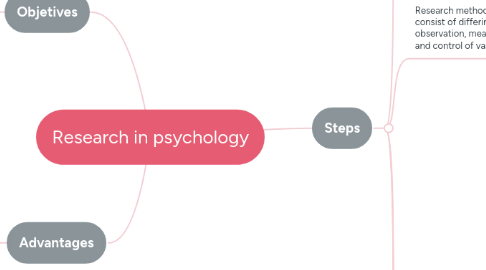
1. Objetives
1.1. Measurement and description: develop measurement techniques that make it possible to describe behavior clearly and precisely.
1.2. Understanding and prediction: we understand events when they can explain the reasons for their occurrence. To evaluate such understanding, scientists make and test hypotheses.
1.3. Application and control: solve everyday problems
2. Advantages
2.1. Clarity and precision
2.2. Intolerance of error
3. Steps
3.1. Formulate an hypothesis: tentative statement about the relationship between two or more variables.
3.1.1. Operational definition: describes the actions or operations that will be used to measure or control a variable.
3.2. Research method and design the study: consist of differing approaches to the observation, measurement, manipulation, and control of variables in empirical studies
3.2.1. Experimental research methods
3.2.1.1. Features
3.2.1.1.1. Groups
3.2.1.1.2. Variables any measurable conditions, events, characteristics, or behaviors that are controlled or observed in a study
3.2.1.2. Evaluation
3.2.1.2.1. Advantages
3.2.1.2.2. Disadvantages
3.2.2. Descriptive/correlational research methods
3.2.2.1. Types
3.2.2.1.1. Naturalistic observation
3.2.2.1.2. Case studies
3.2.2.1.3. Surveys
3.2.2.2. Correlation: exists when two variables are related to each other.
3.2.2.2.1. Correlation coefficient: numerical index of the degree of relationship between two variables.
3.2.2.3. Evaluation
3.2.2.3.1. Advantages
3.2.2.3.2. Disadvantages
3.2.3. Flaws
3.2.3.1. Sampling bias: exists when a sample is not representative of the population from which it was drawn.
3.2.3.1.1. Sample: collection of subjects selected for observation in an empirical study.
3.2.3.1.2. Population: he much larger collection of animals or people (from which the sample is drawn) that researchers want to generalize about.
3.2.3.2. Placebo effects: occur when participants’ expectations lead them to experience some change even though they receive empty, fake, or ineffectual treatment.
3.2.3.3. Self-reported data
3.2.3.3.1. Social desirability bias: which is a tendency to give socially approved answers to questions about oneself.
3.2.3.3.2. Misunderstanding of questionaires
3.2.3.3.3. Memory errors
3.2.3.3.4. Agree/disagree with everything
3.2.3.4. Replication: is the repetition of a study to see whether the earlier results are duplicated.
3.2.3.4.1. Meta-analysis: combines the statistical results of many studies of the same question, yielding an estimate of the size and consistency of a variable’s effects.
3.2.4. Ethics
3.2.4.1. Deception
3.2.4.1.1. 1º People's participation has to be voluntary with the possibility to withdraw at any time
3.2.4.1.2. 2º Not dangerous/harmful treatments
3.2.4.1.3. 3º In case of deception it should be debriefed as soon as possible
3.2.4.1.4. 4º Participants privacy should't be compromised
3.2.4.2. Animal research
3.2.4.2.1. 1º Harmful/painful procedures only when the benefits are substancial
3.2.4.2.2. 2º Decent living conditions
3.3. Collect data
3.3.1. Direct observation: observers are trained to watch and record behavior as objectively and precisely as possible. They may use some instrumentation, such as a stopwatch or video recorder.
3.3.2. Questionnaire: subjects are administered a series of written questions designed to obtain information about attitudes, opinions, and specific aspects of their behavior.
3.3.3. Psychological test: participants are administered a standardized measure to obtain a sample of their behavior. Tests are usually used to assess mental abilities or personality traits.
3.3.4. Psysiological test: an instrument is used to monitor and record a specific physiological process in a subject. Examples include measures of blood pressure, heart rate, muscle tension, and brain activity.
3.3.5. Interview: a face-to-face dialogue is conducted to obtain information about specific aspects of a subject’s behavior.
3.3.6. Examination of archival records: the researcher analyzes existing institutional records (the archives), such as census, economic, medical, legal, educational, and business records.
3.4. Analyze data and draw conclusions
3.4.1. Statistics
3.5. Report the Findings
3.5.1. Journal: is a periodical that publishes technical and scholarly material, usually in a narrowly defined area of inquiry.
